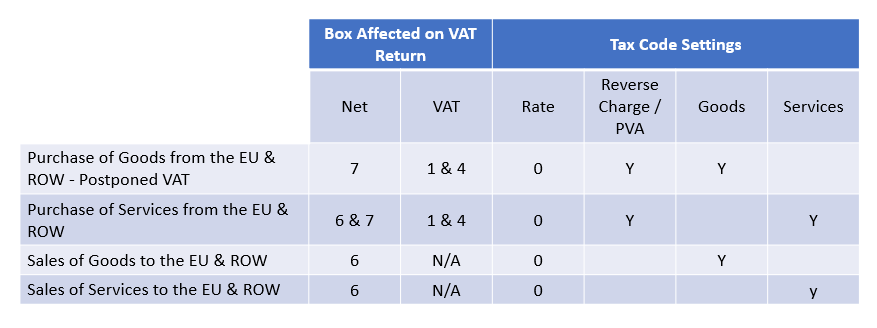To ensure that your transactions are correctly coded from 01/01/2021, we recommend that you take the following action now:
Set up new tax codes
Check the current tax codes in the system by clicking on Setup>Codes Maintenance>Taxes.
If you find that the current set of tax codes no longer cover all of your needs following Great Britain's exit from the EU, we strongly advise against making any changes to existing tax codes, instead, you should set up new codes.
Making changes to existing tax codes will not affect any posted transactions, but will affect historical tax reports and returns. To keep a clean audit trail, we recommend adding new tax codes to reflect any rate changes, or changes to any code settings.
Below is a summary of how tax code settings will affect the VAT 100 report in the system.
Click here for full details of how to add new tax codes in the system.
Update Default Tax Codes
When you post transactions in the system, the default tax code is taken either from the customer or supplier record or from the item used in the transaction. You will need to update the default tax code for all customers and suppliers based in EU countries to ensure that transactions are correctly reported in the VAT return.
You can do this either:
- individually from the customer, supplier or item screen
Or
- in bulk from Setup>Codes Maintenance>Taxes>Tax Codes
Click here for detailed instructions on how to update default tax codes
Start Using the New Tax Codes
You should use the correct tax codes for all import and export transactions dated after 01/01/2021.
If you have already posted transactions to out of date codes, contact support for advice on how to update these before submitting your VAT return.
FAQs
How do I record a VAT only invoice?
- Go to Purchases (or Sales) > Item or Batch invoices
- Create an invoice and enter the net amount (calculated from the amount of VAT you want to appear on the invoice based on the tax rate) and select the correct tax rate
- ie if you want €23 VAT to appear on an invoice at a VAT rate of 23%, then you would enter a net amount of €100
- Create a credit note to the same GL Code as the original invoice with no VAT for the net amount and allocate this to the invoice
- This will leave only the VAT amount outstanding, with no effect on the GL Code used in the Invoice or Credit Note
- Go to Purchases>Payments and Allocations (or Sales > Receipts and Allocations) and allocate the Payment (or Receipt) to the invoice.
